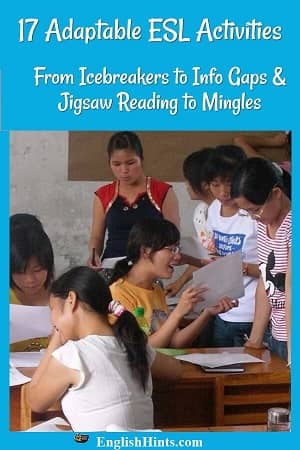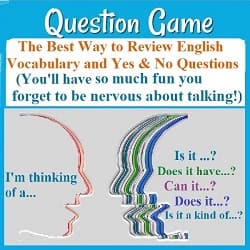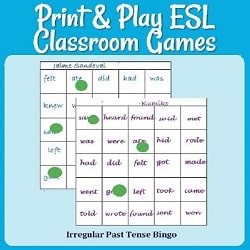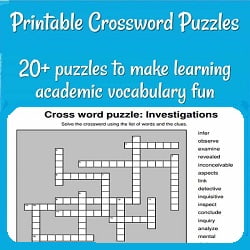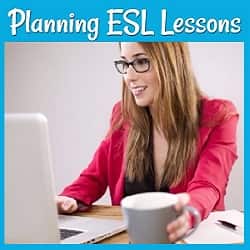17+ Adaptable ESL Activities
These ESL activities give students a chance to use what they have been studying and make it ‘theirs,’ so they can draw on it when needed in their lives. They provide a variety of guided and more independent practice.
Most of these activities can be adapted to many different lessons.
Several are especially useful as icebreakers or warm-ups. Others provide a break or a quick review when there's a little time left near the end of class. Some emphasize listening or speaking; others reading, writing, or vocabulary.
Icebreakers help classmates get acquainted at the start of a new class.
Warm-ups are good at the start of a lesson, especially if not all students arrive on time. They can review the previous day's lesson or help students switch their thinking to English.
It's also very helpful to have a few quick activities in your toolkit for when students get bored or discouraged.
Some of the most valuable teaching advice I was ever given: Always have a back-up plan.
Have one or two special activities in mind to keep students interested
- if the planned lesson turns out to be too hard or too easy;
- if not enough students show up;
- if students are unusually tired or restless;
- or if the equipment needed for the planned lesson doesn’t work.
Short Activities for Icebreakers, Warm-ups, or Breaks
1. "Find someone who." (This is an activity in which Intermediate students ask many classmates questions from a list. They continue until they get a positive response and signature for every question possible.) I liked using this as a warm-up related to the day’s lesson or a review of previous lessons.
If we were working on the past tense, the worksheet would start “Find someone who went to the beach this summer...” If studying the present perfect tense, “Find someone who has broken an arm or leg.” Then ask “Find someone who has been to Disneyland...”, etc. (Customize for your students' interests and location.)
The first time you use it for a new tense it’s important to teach how to convert these statements into questions: “Find s.o. who has broken...” to “Have you broken...?”
When I worked with mixed-level classes, I often gave my beginners the questions to ask. That way they didn’t have to convert from third-person statements to second-person questions. The basic point is to practice related question forms over and over, while learning a little about your classmates.
2. Odd One Out (to practice categories). The teacher gives sets of words that can be grouped in various ways. All but one of the words fit into each possible grouping. (See top of the linked page for a better explanation and examples.) Each student in a group gives his/her opinion about which is "odd." they take turns explaining why their choice is the different one. Then the group decides which explanation makes the most sense.
3. ESL Café’s Idea Cookbook: Icebreakers. Over 100 first day icebreakers submitted by ESL teachers. I haven’t used these, but the ones I looked at looked promising-- and planning the first day of class can be a challenge!
ESL Activities that Emphasize Listening or Speaking
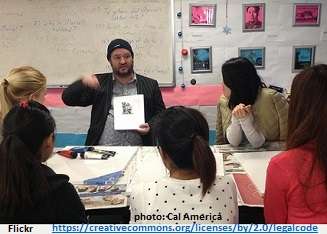
4. Short dialogs let beginners practice useful phrases for everyday situations before they have enough English to improvise on their own.
Dialogs are especially useful for greetings and introductions, asking or giving directions, telephone etiquette (asking to speak with someone, leaving a message, etc. Phone conversations are especially difficult because there are no visual clues to meaning.) For High Beginners or Mixed-Level classes, dialogs can be a good guided practice before trying a role play.
A few more great communicative activities:
>5. Information gaps
>6. Corners
>7. Talking (or writing about) finding things in pictures (What’s happening here?)
> 8. Line up (partner exchange) for short Q & As
> 9. Mingles
> 10. Role plays
> 11. Dictations. (They're not communicative, but they give more listening practice. They're also useful for assessment.) They were quite also popular with my students for end-of-the-week vocabulary tests. Dictations made it easy to see what they had learned.
Dictations, like Bingo (below), encourage students to link what they hear to words they know. They're useful for vocabulary and spelling practice. If you give full-sentence examples for each word, they also give context and expose students to correct sentence structure.
(For more details on these, see ESL Conversation Techniques: Get Your Students Talking.)
ESL Activities Using Reading and Writing
12. “Language Experience.” Students dictate a procedure or story and then practice reading their own work. (Even beginning literacy students can try this. Reading is easier because the subject and vocabulary are already known.)
A small class may work together, dictating to the teacher. In a multi-level classroom students may be divided into mixed-level groups or pairs. Lower-level students may dictate to a higher level student. (That means one who can already read and write in English.)
Students may describe the steps of a process. Examples: how to make coffee or a favorite recipe from their country. Alternately, they can tell a story. Examples: a class field trip or a folk tale they know. They might even imagine the story behind an interesting picture (a wedding, a couple fighting, dramatic weather, etc.)
I have seen beautiful spiral-bound illustrated books put together by beginning ESL classes. (They did have a little teacher editing.) They shared them with other classes in a large adult school. One was stories dictated by individuals about their childhood homes. Another was by refugees telling what they wanted to share about their experiences.
13. Jigsaw readings. Students are divided into groups of 4, each with students A, B, C, and D. They leave their groups to read together with other As or Bs, etc. (All As read certain info, all Bs something else.)
After discussing the reading with others that share their letter, everyone returns to their initial groups. They each teach the info they’ve learned to the rest of the group. This, of course, requires much more talking (as well as reading mastery) than simply having all read the same information at the beginning.
Group division can be arbitrary by the teacher or based on student interests or experience. Almost any reading that divides well into sections works. In my classes, we used this to study information about different community organizations.
Jigsaws can work for test preparation, technical information, or field trip preparation. (ELL students with other subjects to master in English might form study groups. Those that need to review the same class or subject could work together.)
Vocabulary Practice Activities
Several of the activities above can help students learn or review vocabulary. But I just found a site I have to share! I'm so impressed with the way "10 Creative Ways to Teach Vocabulary" encourages imagination. (See #7, in which students need to think of a backstory for why someone wants a tattoo with an assigned word.)
Good End of Class Reviews
14. Add-on lists. (Teacher starts “I went to the store and bought a...’ or “in my Grandma’s attic is a...’ and students go around the room, each repeating the list and adding one item until someone forgets one... A variation is going through the alphabet: Person 1:“I like apples”, p.2: “I like apples and bananas...”)
15. Bingo. (It's very popular and is good hearing practice, with all the advantages of a competitive game. Students can make up their own bingo boards with random order copying of words on the board. We usually did this with a lesson or reading’s vocabulary, but it also works for irregular pasts or other forms.
It can help to review the words and their meanings first. I always give an example sentence after each word. That confirms the word. It also gives students another chance to hear English sentence structure and the vocabulary in context.
16. The Question game (20 Questions.) This is one of my favorites as it’s good question practice and can fill as little or as much time is left in class.
17+. Group competitive games: team relays; eraser tag-- also called ‘flyswatter’ (front member of each team races to the board to be the first to ‘tag’ or ‘swat’ the word that fits the category the teacher mentions, then races back to pass the eraser or fly swatter to the next team member...) Taboo and Charades or Pictionary-type games or Jeopardy. (For these and other game ideas see Free Multiplayer Word Games.)
L.A. Unified has an excellent free pdf e-book, Tools for ESL Lesson Planning. It explains how to conduct many of these (and other) ESL activities in more detail. It describes TPR, dialogs, info-gaps, corners, peer dictation, focused listening, and more. It also has some very helpful sample lesson plans.
Another great source of varied activities is the British Council. They explain the value of each activity as well as how to use it in the classroom.
Some of these ESL activities are quite simple and may not sound like much If you haven’t tried them. But if they match the levels and interests of your class, they can add a lot to a lesson. Enjoy your class, listen to their needs, and feel free to experiment.
Related Pages
The Question Game ("20 Questions") is a great way to end class or provide a break students will love and learn from.
Games are so useful in ESL classes! Get free printable puzzles, vocabulary matching games, and inexpensive packets of games to practice irregular verbs.
Crossword Puzzles are a great way to make vocabulary study more fun. These can be printed for practice offline.
Home> ESL Lesson Plans for Teachers> ESL Activities.
Didn't find what you
needed? Explain what you want in the search box below.
(For example, cognates, past tense practice, or 'get along with.') Click to see the related pages on EnglishHints.
| site search by freefind | advanced |
